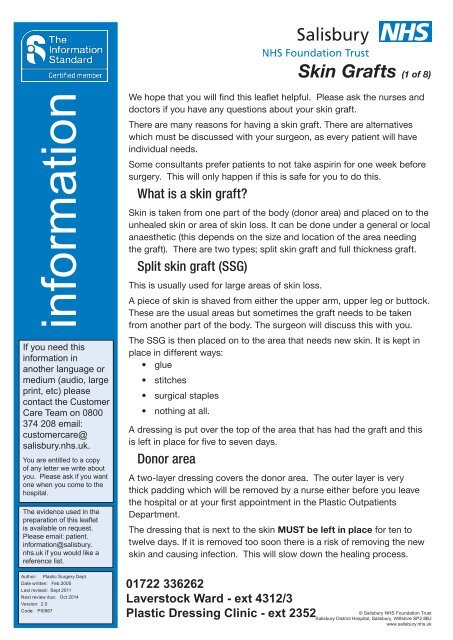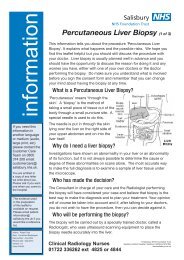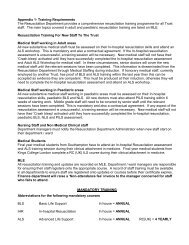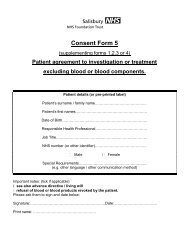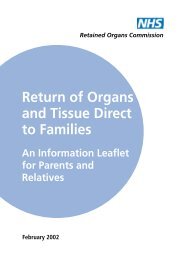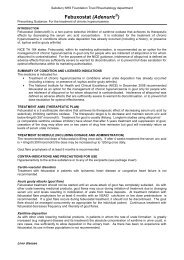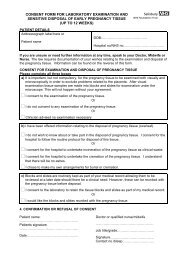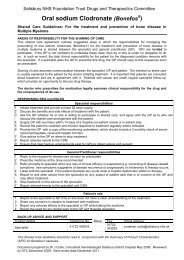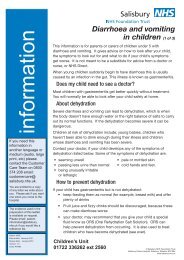Skin Grafts - ICID - Salisbury NHS Foundation Trust
Skin Grafts - ICID - Salisbury NHS Foundation Trust
Skin Grafts - ICID - Salisbury NHS Foundation Trust
Create successful ePaper yourself
Turn your PDF publications into a flip-book with our unique Google optimized e-Paper software.
information<br />
<strong>Skin</strong> <strong>Grafts</strong> (1 of 8)<br />
If you need this<br />
information in<br />
another language or<br />
medium (audio, large<br />
print, etc) please<br />
contact the Customer<br />
Care Team on 0800<br />
374 208 email:<br />
customercare@<br />
salisbury.nhs.uk.<br />
You are entitled to a copy<br />
of any letter we write about<br />
you. Please ask if you want<br />
one when you come to the<br />
hospital.<br />
The evidence used in the<br />
preparation of this leaflet<br />
is available on request.<br />
Please email: patient.<br />
information@salisbury.<br />
nhs.uk if you would like a<br />
reference list.<br />
Author:<br />
Plastic Surgery Dept<br />
Date written: Feb 2005<br />
Last revised: Sept 2011<br />
Next review due: Oct 2014<br />
Version: 2.0<br />
Code: PI0867<br />
We hope that you will find this leaflet helpful. Please ask the nurses and<br />
doctors if you have any questions about your skin graft.<br />
There are many reasons for having a skin graft. There are alternatives<br />
which must be discussed with your surgeon, as every patient will have<br />
individual needs.<br />
Some consultants prefer patients to not take aspirin for one week before<br />
surgery. This will only happen if this is safe for you to do this.<br />
What is a skin graft?<br />
<strong>Skin</strong> is taken from one part of the body (donor area) and placed on to the<br />
unhealed skin or area of skin loss. It can be done under a general or local<br />
anaesthetic (this depends on the size and location of the area needing<br />
the graft). There are two types; split skin graft and full thickness graft.<br />
Split skin graft (SSG)<br />
This is usually used for large areas of skin loss.<br />
A piece of skin is shaved from either the upper arm, upper leg or buttock.<br />
These are the usual areas but sometimes the graft needs to be taken<br />
from another part of the body. The surgeon will discuss this with you.<br />
The SSG is then placed on to the area that needs new skin. It is kept in<br />
place in different ways:<br />
• glue<br />
• stitches<br />
• surgical staples<br />
• nothing at all.<br />
A dressing is put over the top of the area that has had the graft and this<br />
is left in place for five to seven days.<br />
Donor area<br />
A two-layer dressing covers the donor area. The outer layer is very<br />
thick padding which will be removed by a nurse either before you leave<br />
the hospital or at your first appointment in the Plastic Outpatients<br />
Department.<br />
The dressing that is next to the skin MUST be left in place for ten to<br />
twelve days. If it is removed too soon there is a risk of removing the new<br />
skin and causing infection. This will slow down the healing process.<br />
01722 336262<br />
Laverstock Ward - ext 4312/3<br />
Plastic Dressing Clinic - ext 2352<br />
© <strong>Salisbury</strong> <strong>NHS</strong> <strong>Foundation</strong> <strong>Trust</strong><br />
<strong>Salisbury</strong> District Hospital, <strong>Salisbury</strong>, Wiltshire SP2 8BJ<br />
www.salisbury.nhs.uk
Full thickness skin graft (FTSG)<br />
This is most commonly used to replace skin on the hand or face.<br />
The skin is made up of a number of layers. For FTSG, all the layers are used, down to the fat<br />
layer. It is usually taken from:<br />
• behind or in front of the ear<br />
• above the collar bone (clavicle)<br />
• upper inner arm<br />
• groin<br />
The area that it is taken from depends on several things, for example<br />
• colour of skin<br />
• amount of skin required<br />
• previous surgery<br />
• the area needing new skin<br />
There are other areas which can be used which your surgeon will discuss this with you.<br />
The FTSG is then placed on to the area that needs new skin. It is usually kept in place by a<br />
bright yellow dressing. Stitches are used to keep everything from slipping. The ends of the<br />
stitches are kept long and then ‘tied over’ the yellow dressing. This dressing MUST not be<br />
touched for five to seven days.<br />
The donor area is stitched together. A little dressing will be put over the area. Keep the wound<br />
and dressing clean. If this dressing falls off, don’t worry.<br />
Special instructions<br />
After any operation there is always some swelling in the affected part of your body. To help<br />
prevent this, try to rest the affected part during the day in the following way:<br />
• head – sit upright<br />
• arm – hold your hand higher than your heart<br />
• leg - keep it higher than your hip.<br />
At night sleep with your:<br />
• head on an extra pillow<br />
• arm above your heart, i.e. nearer the ceiling<br />
• leg higher than your hip.<br />
<strong>Skin</strong> <strong>Grafts</strong> (2 of 8)<br />
If you don’t do this, you may experience more pain than you should, swelling may be increased<br />
and healing might take longer.<br />
Pain<br />
For many people the donor area is more uncomfortable than the graft area.<br />
• If you experience discomfort or pain from either the donor or graft area, painkillers can be<br />
taken.<br />
• Take the pain killers as instructed. However you should contact Plastic Outpatients or your<br />
GP for advice if you feel that pain has become a problem.<br />
• Most people find taking painkillers regularly, before the pain or discomfort becomes too<br />
bad, keeps it under control.<br />
01722 336262<br />
Laverstock Ward - ext 4312/3<br />
Plastic Dressing Clinic - ext 2352<br />
© <strong>Salisbury</strong> <strong>NHS</strong> <strong>Foundation</strong> <strong>Trust</strong><br />
<strong>Salisbury</strong> District Hospital, <strong>Salisbury</strong>, Wiltshire SP2 8BJ<br />
www.salisbury.nhs.uk
<strong>Skin</strong> <strong>Grafts</strong> (3 of 8)<br />
• Most painkillers have side effects which are listed on the information leaflet that comes<br />
with them. Please read this carefully.<br />
Movement<br />
Depending on where the graft is, a splint or thick dressing will be used to prevent movement.<br />
The surgeon will decide what is to be used during your operation.<br />
Splints and thick dressings are only used if there is a risk of movement preventing healing.<br />
If there is no thick dressing or splint in place, you will be encouraged to move the affected area.<br />
Dressings<br />
These must be kept clean and dry. It is important that only a specialist nurse removes your first<br />
dressing.<br />
A nurse will see you in the Plastic Outpatients, five to seven days after your operation. Dressings<br />
will be removed and your graft will be checked.<br />
• If the graft has healed (taken), it will be left uncovered.<br />
• If the graft has not healed completely, another dressing will be applied.<br />
• The practice nurse at your GP’s surgery can do any further dressings.<br />
• You will be given a letter and new dressings to take with you.<br />
• You will be given a suggested date to make an appointment with the practice nurse.<br />
• The nursing staff in Plastics Outpatients will advise you about bathing, showering and<br />
when to start applying moisturising cream to your newly healed skin.<br />
Things to look for:<br />
• Fluid oozing through the dressing<br />
• The dressing becoming accidentally wet<br />
• You experience worsening pain or discomfort<br />
• An unpleasant smell<br />
If any of these happen you should contact Plastic Outpatients Department Mon - Fri 8am - 5pm,<br />
or Laverstock Ward at all other times. (See below for contact numbers).<br />
Recovery period<br />
Everyone is different and recovers in different ways. You will be able to discuss what you might<br />
expect to happen with the doctor or nurses. They will suggest how long you will need to be off<br />
work, when you can start driving and when you can return to your normal activities.<br />
01722 336262<br />
Laverstock Ward - ext 4312/3<br />
Plastic Dressing Clinic - ext 2352<br />
© <strong>Salisbury</strong> <strong>NHS</strong> <strong>Foundation</strong> <strong>Trust</strong><br />
<strong>Salisbury</strong> District Hospital, <strong>Salisbury</strong>, Wiltshire SP2 8BJ<br />
www.salisbury.nhs.uk
Risks and Complications<br />
Infection<br />
There is a possibility of infection occurring for a number of reasons:<br />
• Smoking<br />
• Poor standards of personal hygiene<br />
• Health problems<br />
• Poor diet<br />
• Scratching the area<br />
• Popping any blisters<br />
• Not following the advice from the specialist team<br />
Signs to look for are:<br />
• Redness<br />
• Pain<br />
• Swelling<br />
• Different smell<br />
• Pus<br />
• Feeling unwell<br />
If you do get an infection, you may be given antibiotics. A swab may be taken from your graft or<br />
donor area to find out what antibiotics are right for treating the infection.<br />
If you have any concerns about your wound, please contact your GP in the first instance.<br />
Smoking<br />
This will increase the risk of infection and graft failure. You should stop or try to cut down. Try<br />
the <strong>NHS</strong> stop smoking help line on 0800 169 0 169 or log onto www.gosmokefree.co.uk for<br />
helpful advice on how to stop smoking<br />
What if I don’t follow the advice given to me?<br />
<strong>Grafts</strong> are very fragile in the early stages. It is very important that you follow all the advice you<br />
have been given.<br />
Graft Failure (partial or complete)<br />
This means that the graft hasn’t healed properly or ‘taken’.<br />
<strong>Skin</strong> <strong>Grafts</strong> (4 of 8)<br />
Infection or a collection of blood under the graft could cause this. This collection of blood is<br />
called a haematoma. If the haematoma is large, it might be necessary for you to go back to<br />
theatre and have it removed.<br />
Sometimes it is not advisable to do anything. It will then be closely monitored to see if it<br />
improves without treatment. The nurses will advise you.<br />
If the graft has not taken completely, the dressing changes will continue. The plan will be to<br />
monitor the graft and leave it to heal on its own, if possible. This may take several weeks.<br />
Blisters<br />
Your newly healed skin on both your donor site and spit skin grafted area will be quite delicate<br />
for several months. They will have a tendency to develop little blisters, which may seem to<br />
appear for no specific reason. At other times blisters may occur as a result of rubbing from<br />
clothes, or after you have knocked the area.<br />
01722 336262<br />
Laverstock Ward - ext 4312/3<br />
Plastic Dressing Clinic - ext 2352<br />
© <strong>Salisbury</strong> <strong>NHS</strong> <strong>Foundation</strong> <strong>Trust</strong><br />
<strong>Salisbury</strong> District Hospital, <strong>Salisbury</strong>, Wiltshire SP2 8BJ<br />
www.salisbury.nhs.uk
It is important not to pop the blisters as this may cause infection:<br />
• keep the area clean<br />
• you can expect the blisters to pop or reduce on their own<br />
• the tendency for blisters to form gradually reduces over time.<br />
<strong>Skin</strong> <strong>Grafts</strong> (5 of 8)<br />
If you are worried about blisters, contact the Plastic Outpatients Department or your GP for<br />
advice.<br />
Donor Site (full thickness skin graft)<br />
Sometimes a haematoma can form in the donor area. You may need to go back to theatre to<br />
have the haematoma removed. Alternatively it may be left for the body to reabsorb.<br />
Sometimes the wound opens due to infection or pressure. It may be left to heal by itself. The<br />
nurse will discuss what your options are for treatment. Each case is assessed according to the<br />
position of the donor site.<br />
Donor site (split skin graft)<br />
Normally these grafts heal within twelve to fourteen days but they can be very itchy – do not<br />
scratch it as this could lead to infection and prevent healing.<br />
The donor site can fail to heal. This can be caused by:<br />
• Infection<br />
• Health problems<br />
• Dressing slippage<br />
• Poor nutrition (diet)<br />
Should I bathe or shower?<br />
It is important for you to have a bath or shower every day. This helps to prevent a build up of<br />
moisturising cream on your skin that can cause white heads to develop.<br />
If you do not feel confident to have a bath or shower alone, make sure that you have someone<br />
with you.<br />
To help prevent infection, the bath must be cleaned and rinsed before you use it. This should<br />
be done with a clear liquid or foam cleaner. A more abrasive cleaner may leave bits in the bath,<br />
which you may find irritates your skin.<br />
How do I look after my body after skin graft<br />
Hygiene<br />
When you wash use a mild or pure non-perfumed soap, such as ‘baby’ soap. This helps to<br />
reduce the chance of your skin being irritated, which can happen with more perfumed soaps.<br />
Follow the advice given to you when cleaning your skin.<br />
Gently pat yourself dry with a clean soft towel.<br />
Washing your hair<br />
If your head or face has had a skin graft, wash your hair with a gentle shampoo such as a ‘baby’<br />
shampoo. This will reduce the likelihood of irritating newly healed areas.<br />
01722 336262<br />
Laverstock Ward - ext 4312/3<br />
Plastic Dressing Clinic - ext 2352<br />
© <strong>Salisbury</strong> <strong>NHS</strong> <strong>Foundation</strong> <strong>Trust</strong><br />
<strong>Salisbury</strong> District Hospital, <strong>Salisbury</strong>, Wiltshire SP2 8BJ<br />
www.salisbury.nhs.uk
How do I look after my grafted skin and donor area?<br />
<strong>Skin</strong> <strong>Grafts</strong> (6 of 8)<br />
It is important to moisturise your skin after you have had a wash. The oil and sweat glands are<br />
often damaged after a skin graft, making the scar area drier than normal skin.<br />
New skin will benefit from massage with a moisturising cream to improve its quality, ideally 2-3<br />
times a day. You need to use a non-perfumed cream. This hospital uses sunflower oil cream.<br />
Massage will help to keep the scarred areas supple and moist and help to reduce itchiness.<br />
Ideally your skin should be massaged when warm. The best time is after a bath or shower.<br />
Do not use too much cream, it will not be absorbed. It is important that you make sure that it is<br />
massaged well into the skin.<br />
What kind of clothes would be best?<br />
If you have a large area of skin graft or donor site you will find that your skin is more sensitive to<br />
hot and cold temperatures.<br />
If your graft or donor site lies in an area of your body which would normally be covered by<br />
clothes you will probably feel more comfortable if you wear loose clothing made of natural fibres<br />
such as cotton, linen or silk rather than man made fibres such as polyester.<br />
You may be more sensitive to extremes of temperature and should dress so that you are<br />
comfortable.<br />
Shoes<br />
If your feet have had a skin graft, it is important that your shoes are comfortable and do not rub<br />
the newly healed skin.<br />
You may need to change from your normal shoes. You may find that you need a larger size than<br />
usual and you will need to make sure that the style of shoe does not cause problems to your<br />
skin.<br />
Eating and drinking<br />
When you are recovering from an operation it is important to eat a well-balanced and healthy diet<br />
to help the wound to heal.<br />
It is important to remember to drink plenty of fluids, particularly water. Having been in hospital,<br />
where drinking is encouraged, it is easy to forget to drink once you are home.<br />
Will I have scars?<br />
With skin grafting there will be some scarring. The degree depends on the depth of the graft, the<br />
length of time it takes to heal, plus your own skin’s response.<br />
It is impossible to predict the severity of the scarring that will occur. It depends on:<br />
• the size of the graft<br />
• area on the body<br />
• depth of the graft<br />
• your skin type<br />
01722 336262<br />
Laverstock Ward - ext 4312/3<br />
Plastic Dressing Clinic - ext 2352<br />
© <strong>Salisbury</strong> <strong>NHS</strong> <strong>Foundation</strong> <strong>Trust</strong><br />
<strong>Salisbury</strong> District Hospital, <strong>Salisbury</strong>, Wiltshire SP2 8BJ<br />
www.salisbury.nhs.uk
To help control scarring and joint tightness it is advisable to:<br />
<strong>Skin</strong> <strong>Grafts</strong> (7 of 8)<br />
• massage and cream your scars as • exercise and stretch as you have<br />
you have been advised<br />
been taught<br />
• keep active<br />
• follow any special advice<br />
• wear any splints or support garments • make sure that the splints stay well<br />
that you have been given<br />
fitting<br />
Why do my scars change colour?<br />
Scar or donor areas may appear dark pink, deep red or purple. Eventually the scar will become<br />
pale, soft and supple.<br />
Discolouration of areas is normal because of changes in the blood circulation and the make up<br />
of the newly healed skin.<br />
The change in colour may be more noticeable at different times of the year, when your body<br />
temperature changes or when you are doing activities which increase heart rate.<br />
After several months the skin’s natural colour may return to areas that have had split skin<br />
grafting.<br />
• FTSG may have some permanent discolouration and skin may always be a different colour<br />
and texture compared to the surrounding skin.<br />
• FTSG keep the colour of the area from where they have been removed so are used more<br />
for head and neck areas.<br />
• SSG look thin and less supple and have variable colourings.<br />
<strong>Skin</strong> camouflage<br />
<strong>Skin</strong> camouflage is the application of specialist cover creams to improve the appearance of<br />
scarring and other disfiguring skin conditions.<br />
The creams are used to conceal blemishes and they provide effective, long lasting, waterproof<br />
cover on any area of the body. They are appropriate for everyone.<br />
The British Red Cross offers a free skin camouflage service provided by volunteer practitioners.<br />
To access the service a doctor’s referral is required and, subject to the GP’s approval, the<br />
creams are available on prescription.<br />
Can I go out in the sun?<br />
We do not recommend exposing your grafted area or donor site to the sun for about two years<br />
following surgery. It is essential you protect your skin from the sun.<br />
Follow these directions carefully: -<br />
• avoid direct sunlight on the affected areas for at least two years after healing has<br />
occurred.<br />
• wear cotton, silk or linen clothing<br />
• always use total sunblock (for sensitive skin) on areas you are unable to protect<br />
01722 336262<br />
Laverstock Ward - ext 4312/3<br />
Plastic Dressing Clinic - ext 2352<br />
© <strong>Salisbury</strong> <strong>NHS</strong> <strong>Foundation</strong> <strong>Trust</strong><br />
<strong>Salisbury</strong> District Hospital, <strong>Salisbury</strong>, Wiltshire SP2 8BJ<br />
www.salisbury.nhs.uk
<strong>Skin</strong> <strong>Grafts</strong> (8 of 8)<br />
with clothing, even on a cloudy day. Sunblock must be re-applied according to the<br />
manufacturer’s instructions and particularly after swimming.<br />
Problem<br />
Blisters may occur<br />
on split skin grafted<br />
areas as well as<br />
donor sites. They<br />
are common for the<br />
first few months<br />
<strong>Skin</strong> breakdown<br />
which can happen<br />
over a long period of<br />
time<br />
Whiteheads and<br />
blackheads are a<br />
common problem<br />
which decrease over<br />
time<br />
Cysts usually occur<br />
in the first 6 months<br />
and can be very<br />
uncomfortable.<br />
They may appear as<br />
red, black or yellow<br />
lumps under the skin<br />
Possible problems and treatment<br />
Why might this Treatment<br />
happen?<br />
Rubbing from • Leave the blister<br />
clothing or accidental alone<br />
knocks to the skin • Do not pop it<br />
Small knocks,<br />
rubbing, scratching<br />
or infection<br />
They can be caused<br />
by such things as<br />
cream, dirt or soap<br />
collecting in the<br />
uneven scar tissue<br />
Cysts can occur as<br />
a result of skin cells<br />
or dirt becoming<br />
trapped under the<br />
graft leading to a<br />
localised infection<br />
• Use a dressing to<br />
protect the blister<br />
• If the blister becomes<br />
larger or infected<br />
contact your practice<br />
nurse<br />
• Contact your GP for<br />
advice<br />
• Gently wash area with<br />
a soft sponge and<br />
warm soapy water<br />
• Soak in warm water<br />
and then gently wash<br />
the area with a soft<br />
sponge in soft motion<br />
How could it be<br />
prevented?<br />
• Follow your skin care<br />
instructions carefully<br />
• Avoid tight fitting<br />
clothing<br />
• Follow all the<br />
information you have<br />
been given<br />
• Try not to knock the<br />
vulnerable area<br />
• Do not scratch<br />
• Keep the skin clean<br />
• Wash the skin to<br />
remove old cream<br />
before applying fresh<br />
• Keep the skin clean<br />
01722 336262<br />
Laverstock Ward - ext 4312/3<br />
Plastic Dressing Clinic - ext 2352<br />
© <strong>Salisbury</strong> <strong>NHS</strong> <strong>Foundation</strong> <strong>Trust</strong><br />
<strong>Salisbury</strong> District Hospital, <strong>Salisbury</strong>, Wiltshire SP2 8BJ<br />
www.salisbury.nhs.uk


